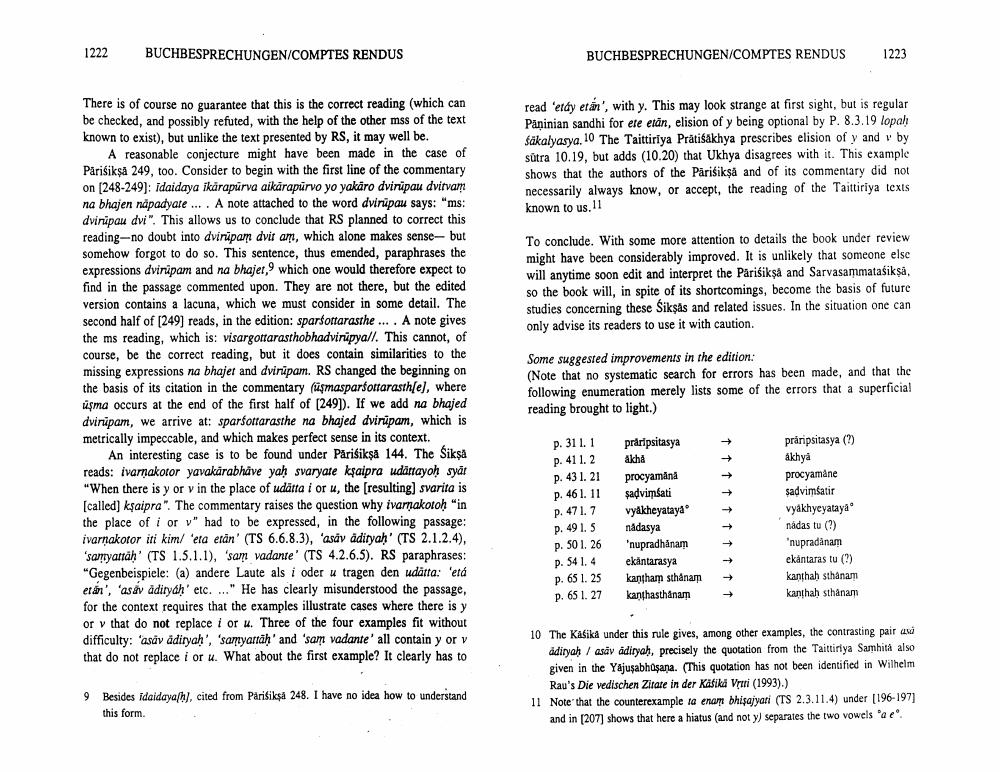Book Title: Buchbesprechungen Comptes Rendus Author(s): Johannes Bronkhorst Publisher: Johannes Bronkhorst View full book textPage 7
________________ 1222 BUCHBESPRECHUNGEN/COMPTES RENDUS BUCHBESPRECHUNGEN/COMPTES RENDUS 1223 read 'etdy etan', with y. This may look strange at first sight, but is regular Paninian sandhi for ete etan, elision of y being optional by P. 8.3.19 lopah Säkalyasya. 10 The Taittiriya Prátisakhya prescribes elision of y and v by sūtra 10.19, but adds (10.20) that Ukhya disagrees with it. This example shows that the authors of the Parisikşå and of its commentary did not necessarily always know, or accept the reading of the Taittiriya texts known to us. 11 To conclude. With some more attention to details the book under review might have been considerably improved. It is unlikely that someone else will anytime soon edit and interpret the Parisiksa and Sarvasammatasiksa, so the book will, in spite of its shortcomings, become the basis of future studies concerning these Sikşas and related issues. In the situation one can only advise its readers to use it with caution. There is of course no guarantee that this is the correct reading (which can be checked, and possibly refuted, with the help of the other mss of the text known to exist), but unlike the text presented by RS, it may well be. A reasonable conjecture might have been made in the case of Pärisiksa 249, too. Consider to begin with the first line of the commentary on 1248-249): idaidaya ikärapurva aikarapurvo yo yakaro dvinipau dvitvam na bhajen napadyate .... A note attached to the word dvinipou says: "ms: dvinipau dvi". This allows us to conclude that RS planned to correct this reading-no doubt into dviripam dvir am, which alone makes sense- but somehow forgot to do so. This sentence, thus emended, paraphrases the expressions dvinipam and na bhajer, which one would therefore expect to find in the passage commented upon. They are not there, but the edited version contains a lacuna, which we must consider in some detail. The second half of (249) reads, in the edition: sparsottarasthe... A note gives the ms reading, which is: visargottarasthobhadvirüpya//. This cannot, of course, be the correct reading, but it does contain similarities to the missing expressions na bhajet and dvirüpam. RS changed the beginning on the basis of its citation in the commentary (usmasparfortarasth(e), where uşma occurs at the end of the first half of [249]). If we add na bhajed dvinipam, we arrive at: sparfotarasthe na bhajed dvirūpam, which is metrically impeccable, and which makes perfect sense in its context. An interesting case is to be found under Parisiksa 144. The Siksa reads: ivarnakotor yavakarabhave yah svaryate kşalpra udattayoh syd "When there is y or v in the place of udätta i oru, the (resulting) svarita is [called) ksaipra". The commentary raises the question why ivarnakotoh "in the place of i ory" had to be expressed, in the following passage: ivarnakotor iti kim/ eta eran' (TS 6.6.8.3), 'asáv adityah' (TS 2.1.2.4), 'samyartah' (TS 1.5.1.1), 'sam vadante' (TS 4.2.6.5). RS paraphrases: "Gegenbeispiele: (a) andere Laute als i oder u tragen den udätta: 'etá etán', 'asáv adirydh' etc. ..." He has clearly misunderstood the passage, for the context requires that the examples illustrate cases where there is y or v that do not replace i or u. Three of the four examples fit without difficulty: 'asáv adiryah', 'sarrtyartah' and 'sam vadante' all contain y or v that do not replace i or u. What about the first example? It clearly has to Some suggested improvements in the edition: (Note that no systematic search for errors has been made, and that the following enumeration merely lists some of the errors that a superficial reading brought to light.) p. 411.2 p. 431.21 p. 461.11 p. 471. 7 p. 491.5 p. 50 1. 26 p. 54 1.4 p. 65 1.25 p. 651. 27 praripsitasya akha procyamana sadvimati vyakheyatayao nadasya "nupradhanam ekantarasya kantham sthanam kanthasthanam ttttttt präripsitasya (?) akhya procyamane sadvimsatir vyakhyeyataya nadas tu (?) "nupradanam ekantaras tu (?) kanthah sthanam kanthah sthanam 10 The Kasika under this rule gives, among other examples, the contrasting pair a adiryah / asav adiryah, precisely the quotation from the Taittiriya Samhith also given in the Yajusabhsana. (This quotation has not been identified in Wilhelm Rau's Die vedischen Zitate in der Katika Viti (1993).) 11 Note that the counterexample ta enam bhisayari (TS 2.3.11.4) under (196-197) and in [207) shows that here a hiatus (and not y) separates the two vowels 'ae. 9 Besides Idaidaya/h), cited from Parifiksi 248. I have no idea how to understand this form.Page Navigation
1 ... 5 6 7 8
